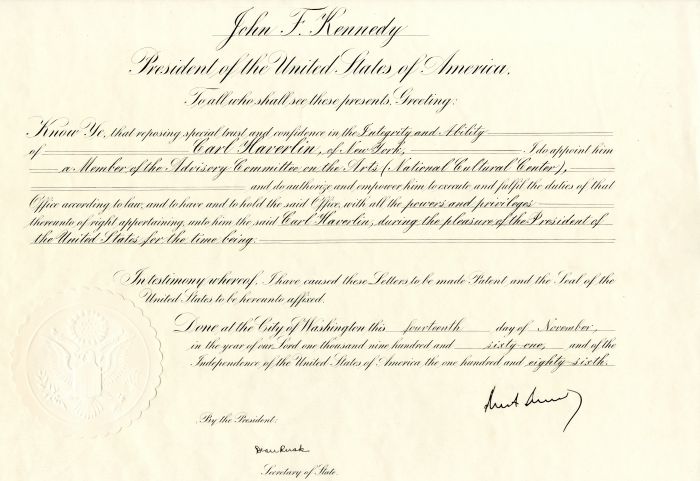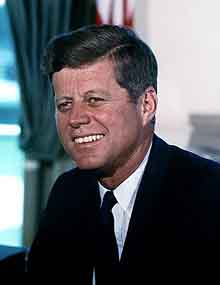JFK Signed Appointment - Autographs
Inv# AU1598 Autograph
John F. Kennedy signed Appointment to Carl Haverlin for Membership of the Advisory Committee of the Arts known as the National Cultural Center. Measures 17.5" wide and 13" tall. Kennedy signs very nicely with nothing effecting the signature. Dated November 14, 1961. Made out to Carl Haverlin for Membership of the Advisory Committee of the Arts known as the National Cultural Center. Haverlin has a colorful history of Radio, Music and Broadcasting. Also signed by Dean Rusk, Secretary of State.

John Fitzgerald Kennedy (May 29, 1917 – November 22, 1963), often referred to by his initials JFK, was the 35th president of the United States, serving from 1961 until his assassination in 1963. Kennedy served at the height of the Cold War, and the majority of his work as president concerned relations with the Soviet Union and Cuba. A Democrat, Kennedy represented Massachusetts in both houses of the U.S. Congress prior to becoming president. Kennedy was born into a wealthy, political family in Brookline, Massachusetts. He graduated from Harvard University in 1940, before joining the U.S. Naval Reserve the following year. During World War II, he commanded a series of PT boats in the Pacific theater and earned the Navy and Marine Corps Medal for his service. After a brief stint in journalism, Kennedy represented a working-class Boston district in the U.S. House of Representatives from 1947 to 1953. He was subsequently elected to the U.S. Senate and served as the junior senator for Massachusetts from 1953 to 1960. While in the Senate, Kennedy published his book, Profiles in Courage, which won a Pulitzer Prize. In the 1960 presidential election, he narrowly defeated Republican opponent Richard Nixon, who was the incumbent vice president. Kennedy’s humor, charm, and youth in addition to his father’s money and contacts were great assets in the campaign. Kennedy expertly presented his platform and himself using a new medium, television. Kennedy was the first Catholic elected president. Kennedy's administration included high tensions with communist states in the Cold War. As a result, he increased the number of American military advisers in South Vietnam. The Strategic Hamlet Program began in Vietnam during his presidency. In April 1961, he authorized an attempt to overthrow the Cuban government of Fidel Castro in the failed Bay of Pigs Invasion. Kennedy authorized the Cuban Project in November 1961. He rejected Operation Northwoods (plans for false flag attacks to gain approval for a war against Cuba) in March 1962. However, his administration continued to plan for an invasion of Cuba in the summer of 1962. The following October, U.S. spy planes discovered Soviet missile bases had been deployed in Cuba; the resulting period of tensions, termed the Cuban Missile Crisis, nearly resulted in the breakout of a global thermonuclear conflict. He also signed the first nuclear weapons treaty in October 1963. Kennedy presided over the establishment of the Peace Corps, Alliance for Progress with Latin America, and the continuation of the Apollo space program with the goal of landing a man on the Moon. He also supported the civil rights movement, but was only somewhat successful in passing his New Frontier domestic policies. On November 22, 1963, he was assassinated in Dallas. Vice President Lyndon B. Johnson assumed the presidency upon Kennedy's death. Marxist and former U.S. Marine Lee Harvey Oswald was arrested for the state crime, but he was shot and killed by Jack Ruby two days later. The FBI and the Warren Commission both concluded Oswald had acted alone in the assassination, but various groups contested the Warren Report and believed that Kennedy was the victim of a conspiracy. After Kennedy's death, Congress enacted many of his proposals, including the Civil Rights Act and the Revenue Act of 1964. Despite his truncated presidency, Kennedy ranks highly in polls of U.S. presidents with historians and the general public. His personal life has also been the focus of considerable sustained interest following public revelations in the 1970s of his chronic health ailments and extramarital affairs. David Dean Rusk (February 9, 1909 – December 20, 1994) was the United States Secretary of State from 1961 to 1969 under presidents John F. Kennedy and Lyndon B. Johnson. Rusk is one of the longest serving U.S. Secretaries of State, behind only Cordell Hull. Born in Cherokee County, Georgia, Rusk taught at Mills College after graduating from Davidson College. During World War II, Rusk served as a staff officer in the China Burma India Theater. He was hired by the United States Department of State in 1945 and became Assistant Secretary of State for Far Eastern Affairs in 1950. In 1952, Rusk became president of the Rockefeller Foundation. After winning the 1960 presidential election, Kennedy asked Rusk to serve as secretary of state. He supported diplomatic efforts during the Cuban Missile Crisis and, though he initially expressed doubts about the escalation of the U.S. role in the Vietnam War, became known as one of its strongest supporters. Rusk served for the duration of the Kennedy and Johnson administrations before retiring from public office in 1969. After leaving office, he taught international relations at the University of Georgia School of Law. The John F. Kennedy Center for the Performing Arts (formally known as the John F. Kennedy Memorial Center for the Performing Arts, and commonly referred to as the Kennedy Center) is the United States National Cultural Center, located on the Potomac River in Washington, D.C. It was named in 1964 as a memorial to assassinated President John F. Kennedy. Opened on September 8, 1971, the center hosts many different genres of performance art, such as theater, dance, orchestras, jazz, pop, and folk music. Authorized by the 1958 National Cultural Center Act of Congress, which requires that its programming be sustained through private funds, the center represents a public–private partnership. Its activities include educational and outreach initiatives, almost entirely funded through ticket sales and gifts from individuals, corporations, and private foundations. The building, designed by architect Edward Durell Stone, was constructed by Philadelphia contractor John McShain, and is administered as a bureau of the Smithsonian Institution. An earlier design proposal called for a more curvy, spaceship-inspired building similar to how the Watergate complex appears today. The center receives annual federal funding to pay for building maintenance and operation. The idea for a national cultural center dates to 1933 when First Lady Eleanor Roosevelt discussed ideas for the Emergency Relief and Civil Works Administration to create employment for unemployed actors during the Great Depression. Congress held hearings in 1935 on plans to establish a Cabinet level Department of Science, Art and Literature, and to build a monumental theater and arts building on Capitol Hill near the Supreme Court building. A 1938 congressional resolution called for construction of a "public building which shall be known as the National Cultural Center" near Judiciary Square, but nothing materialized. The idea for a national theater resurfaced in 1950, when U.S. Representative Arthur George Klein of New York introduced a bill to authorize funds to plan and build a cultural center. The bill included provisions that the center would prohibit any discrimination of cast or audience. In 1955, the Stanford Research Institute was commissioned to select a site and provide design suggestions for the center. From 1955 to 1958, Congress debated the idea amid much controversy. A bill was finally passed in Congress in the summer of 1958 and on September 4, President Dwight D. Eisenhower signed into law the National Cultural Center Act which provided momentum for the project. This was the first time that the federal government helped finance a structure dedicated to the performing arts. The legislation required a portion of the costs, estimated at $10–25 million, to be raised within five years of the bill's passage. Edward Durell Stone was selected as architect for the project in June 1959. He presented preliminary designs to the President's Music Committee in October 1959, along with estimated costs of $50 million, double the original estimates of $25–30 million. By November 1959, estimated costs had escalated to $61 million. Despite this, Stone's design was well received in editorials in The Washington Post, Washington Star, and quickly approved by the United States Commission of Fine Arts, National Capital Planning Commission, and the National Park Service. The National Cultural Center was renamed the John F. Kennedy Center for the Performing Arts in 1964, following the assassination of President Kennedy.










Ebay ID: labarre_galleries